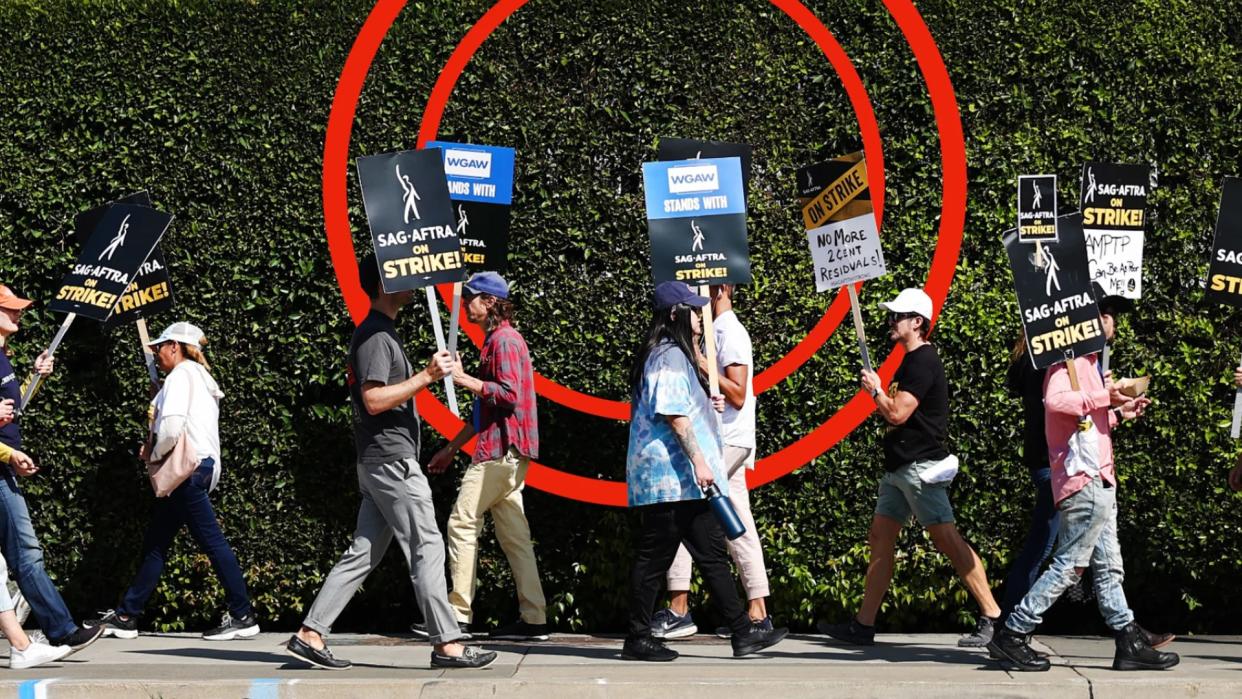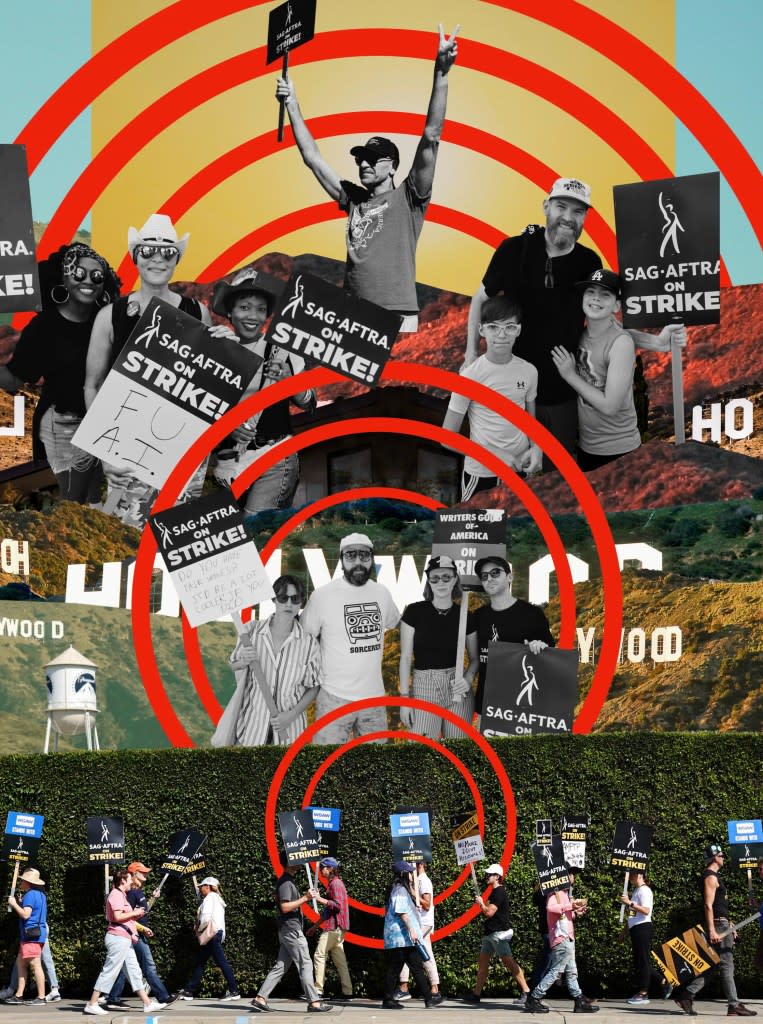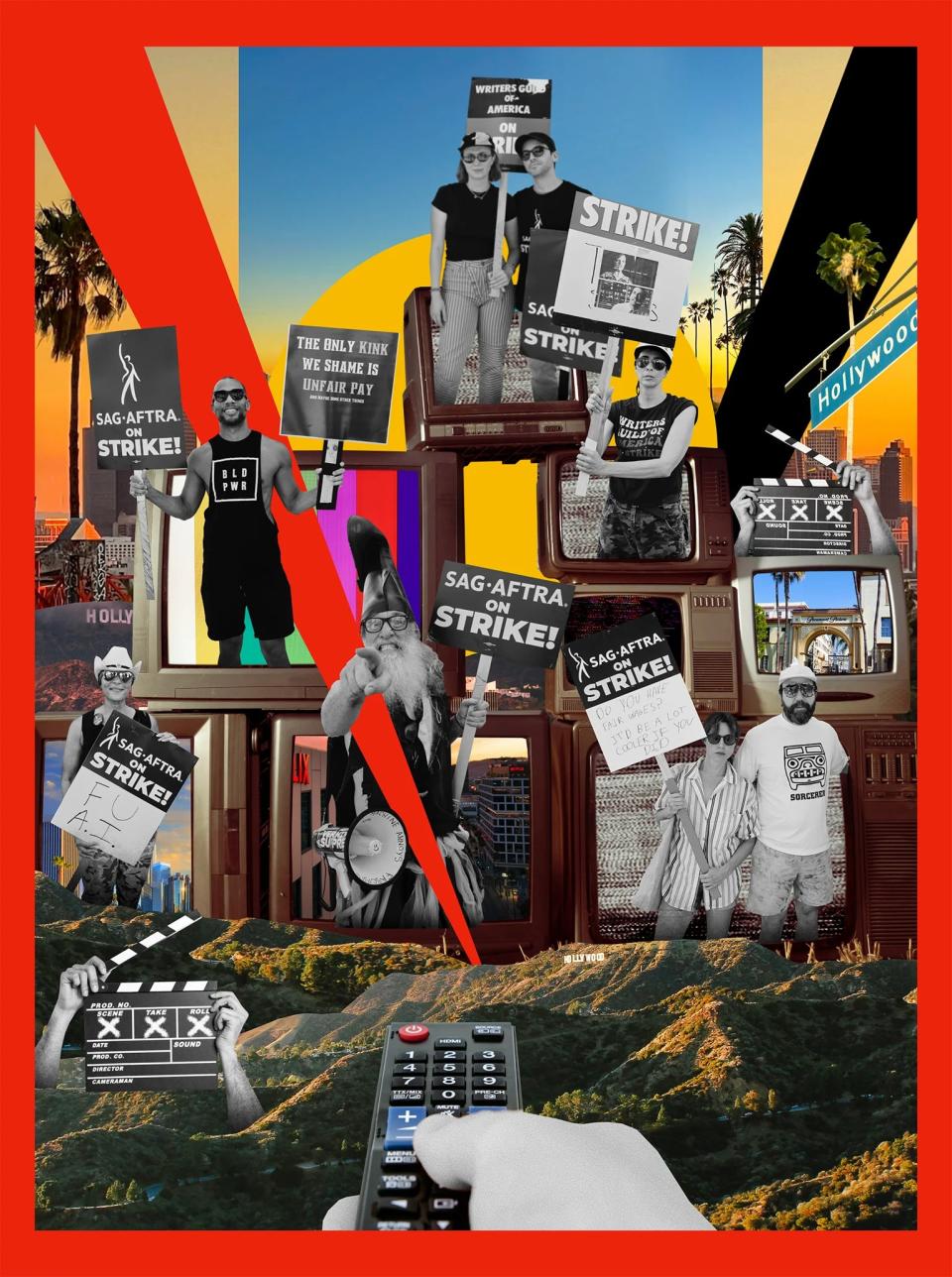Diary of a Strike



The SAG-AFTRA and WGA labor disputes of 2023 put tens of thousands of people out of work for more than half the year, but the psychological impact was as great as the economic one. The ripple effects continue to reverberate through all of entertainment
Artwork by Alexis Chivir-ter Tsegba
By Sharon Waxman
The labor actions of 2023 were a once-in-a-lifetime event. For eight months, the entertainment industry ground to a halt as the lifeblood of entertainment content—the writers—and the faces of movies and television—the actors—left the playing field and instead picked up picket signs.
It had been decades since management faced off with the creative community, and it was ugly. It was emotional. It was public. It was nasty. At TheWrap, we covered the daily grind of the strikes minute by minute, week after week, month after month. The following is a timeline of the signature moments of a landmark year.

May 1 It begins. Hollywood writers fail to reach a deal for a new contract with the Alliance of Motion Picture and Television Producers by a previously set deadline. The leadership of the Writers Guild of America, West (WGAW) and Writers Guild of America, East (WGAE) unanimously approves a strike on the eve of May 2, the first of its kind since the 2007–08 strike upended the industry.
May 2 The Writers Guild strike launches as 11,500 screenwriters put down their pens. Hollywood, largely expecting this development, braces for what looks to be a long fight.
May 11 In solidarity, Jeopardy! host Mayim Bialik exits the final week of taping of the game show’s 39th season, joining the likes of Drew Barrymore, who steps down as the host of this year’s MTV Movie & TV Awards for the same reason.
June 5 Second wave coming. Nearly 98 percent of the Screen Actors Guild votes to strike if it cannot reach a deal with the AMPTP by June 30.
June 23 The Directors Guild of America agrees to a new contract with the AMPTP with wage increases, better residuals and some protections against artificial intelligence tools.
July 12 As the clock ticks down to a contract deadline for the Screen Actors Guild and AMPTP, no word from the two sides or a federal mediator. As midnight passes with no deal, the industry waits. About 45 minutes past the deadline, SAG-AFTRA issues a statement that they have walked away from the table.
July 13 SAG-AFTRA president Fran Drescher issues a scathing jeremiad to the Hollywood studio chiefs, taking them to task for their greed, their selfishness and their overall chutzpah. It is probably her greatest performance, made more convincing by the fact that she surely means it: “We are the victims here. We are being victimized by a very greedy entity. I am shocked by the way the people that we have been in business with are treating us,” she says in a video that goes viral.
“I cannot believe it, quite frankly, how far apart we are on so many things. How they plead poverty, that they’re losing money left and right when giving hundreds of millions of dollars to their CEOs. It is disgusting. Shame on them. They stand on the wrong side of history.”
That same day, SAG-AFTRA joins the ranks of the WGA and authorizes its own strike, putting several movies and TV shows on indefinite holds and resulting in the cast of Christopher Nolan’s Oppenheimer walking out of the film’s U.K. premiere.
Split screen: Meanwhile, Disney CEO Bob Iger sticks his foot in it while ensconced in the Loro Piano luxury of Sun Valley at the Allen conference. The private jets are lined up on the tarmac. The Patagonia vests are in abundance. Iger says the studios could not possibly have made a deal with the guilds because their demands were “just not realistic.”
“It’s very disturbing to me,” Iger says to CNBC. “We’ve talked about disruptive forces on this business and all the challenges that we’re facing and the recovery from COVID—which is ongoing, it’s not completely back. This is the worst time in the world to add to that disruption.” Guild members are angry and insulted. Other studio executives are pissed off. People who know Iger are totally confused since it’s very unlike him to put a foot wrong when it comes to public appearances. (He later tells friends in private that he knew what he was doing and was only telling the truth.)
July 24 Social media influencers are told they will be barred from SAG-AFTRA if they accept work from blacklisted studios or streaming services during the strike.
July 26 Rally in Times Square with leaders and members of both guilds. Brian Cranston takes a megaphone and yells: “Give us our dignity!” Nobody thinks Brian Cranston is starving, but the punch lands and the video goes very wide.
July 27-28 Wall Street is getting restless. Analysts put out guidance saying the studios have handled this poorly, appear to all the world like a bunch of greedy fat cats, and they should sit down and make a deal.
Hollywood publicists begin to freak out as their businesses dwindle to nothing. Their clients cannot work—cannot do red carpets, cannot do any media appearances at all. Planning for the fast-approaching fall season is in full disarray. Panic is beginning to set in as August looms.
Venice, Telluride and Toronto film festivals are all moving forward, but with no guarantee of any acting talent being permitted to appear. The publicists ask for and get a meeting with two of the union leaders on strike and feel that they are being asked to “sacrifice” like everyone else. All feel disrespected.
July 31 After three weeks of nonstop pummeling in the press, the studios decide to get their act together. The CEOs meet over the weekend and resolve to figure out how to move forward. Monday, their labor negotiators roll up their sleeves again to come close to a consensus on the thorniest issues—for the writers, the minimum work engagement and mandatory staffing; for actors, the AI issue—as well as residuals. TheWrap breaks this bit of news, which is followed the next day by the AMPTP inviting the WGA to discuss returning to the negotiating table.
August 4 Fizzle. The two sides meet and—stalemate. No progress is made. Strike continues. No view to a path to progress. WGA representatives meet with studios but fail to reach a deal, saying AMPTP was open to increasing offers on a “few writer-specific TV minimums and talk about AI” but wasn’t willing to engage in screenwriters’ issues and other proposals.
August 7 Fran Drescher says AMPTP has not reached out to go back to the table. In other words: no news.
August 9 Liz Hannah, producer and screenwriter of The Post, tweets: “Day 100. If you’re feeling down, feel it. You’re not wrong. It’s scary. But we are all here together. You are not alone. Fuck those guys.”
Entertainment journalist Mark Harris tweets: “Every day these strikes continue is a fresh reminder of the void of ethical, moral, and business leadership at the top of the AMPTP. They are inadequate custodians of a great industry, chasing the chimera of endless Wall Street growth at the expense of decency and common sense.”
It’s not going so well for the studios.
August 22 The studio CEOs determine that they simply
must end the strike. The deadline in mind—the outside date to get this done—has been Labor Day. They request a meeting with the Writers Guild leadership to press the case that the studios have made significant concessions around minimum guarantees for the writers rooms, guaranteed transparency in streaming data every quarter, and firm assurances on copyright as it relates to artificial intelligence.
To their surprise, the guild leadership tells them it’s not good enough. In frustration, the CEOs decide to release their offer publicly—to what end is unclear, but it succeeds in infuriating the guild leadership and membership. It is read as a move to divide the union. The strategy backfires, and the guild membership is furious. “They made an enormous tactical error because they just made everybody mad,” showrunner Mike Royce says. “They are trying to leapfrog over an important part of the deal-making process by going around our negotiating committee.”
The guild condemns the move and later issues its formal response.
At this point, the two sides are negotiating by press release. The trust, already frayed, is broken. This new breakdown leads to two more weeks of utter silence. And no direct talks.
August 30 Venice Film Festival opens without any Hollywood stars. Bradley Cooper misses the premiere of his new film, Maestro, in which he plays composer Leonard Bernstein and on which he is cowriter and director. Though technically he could attend as the director, he chooses not to come in solidarity with his actor colleagues. The festival goes on, with one major film premiere after another, including director luminaries such as David Fincher, Sofia Coppola and Ava DuVernay—but no actors.
September 1 Cavernous, yawning silence from Hollywood as the two sides continue their standoff. No talks are happening and no leaks to the media.
September 8 Toronto Film Festival opens with no actors except a handful—Nicolas Cage, Jessica Chastain and Peter Sarsgaard—who received waivers.
September 11 Hollywood showrunners are anxious with staff unable to work. They request a meeting with WGA leadership. The guild cancels the meeting, and showrunners, including Kenya Barris (Blackish) and Noah Hawley (Fargo), are furious and demand more movement on the strike talks. Drew Barrymore calls her talk show back. So does Jennifer Hudson. So does Bill Maher. Rep. Alexandria Ocasio-Cortez calls him a scab. Lots of social blowback for everyone.
September 14 After nearly a month with no talks, WGA invites AMPTP back to the table, finally setting a date for the following week.
September 20 At long last, the WGA and AMPTP meet to start working sessions on the strike issues. In attendance: Disney’s Bob Iger; Warner Bros Discovery’s David Zaslav; Netflix’s Ted Sarandos; NBCUniversal’s Donna Langley. No deal.
September 21 Guild leaders and CEOS are back. They negotiate until 8 pm. No deal.
September 22 Both sides are back, all day. Still no deal. Word comes that they had a deal at 5 pm, but rumor spreads that the retired, hard-as-nails former chief WGA negotiator David Young has sent the negotiators back for two more points. True or not, no deal.
September 23 The deal is so close, the whole town can taste it. It’s Saturday, and the lawyers are hammering out language. Word is a deal is coming. But the day ends for negotiators at 9 pm and still: No deal.
September 24 It’s Yom Kippur Eve. Now is the time. Everyone in Hollywood has their eyes trained on “how the Yom Kippur eve deal got done.” The informal deadline is sunset Sunday,
when the Jewish holiday takes half the town (and half the negotiators, and at least one journalist, me) offline for 24 hours. Sunset inches closer. Sunset comes. Still no announcement at all. Finally at 7:15 pm, as the sounds of Kol Nidre begin to ring through the synagogues (where Donna Langley, David Zaslav and
Bob Iger could reliably be said to be), the announcement comes: We have a deal.

October 2 SAG-AFTRA leaders meet to negotiate with the four Hollywood CEOs for the first time in more than a month.
October 13 After five direct meetings over 10 days of talks, the AMPTP suspends negotiations. “The gap” is “too great,” they say in a statement issued over a new demand for a $1-per-subscriber streaming service fee that would go to the guild. Hollywood sinks back into panic.
October 28-29 SAG-AFTRA and AMPTP work all weekend. The studio side tells TheWrap before the weekend that if an agreement is not reached in a week, they’re giving up until after the new year:
“According to an individual with knowledge of their thinking, the studios believe that if they can’t reach a deal in the next week with the Screen Actors Guild, which has been on strike since July 14, then no new production will be able to start before 2024.
If that is the case, the studios further believe, then the fall television season is lost, and new movies won’t be able to
come out until next summer. In this scenario, early November would be the drop-dead date to salvage any ability to put television or movies into production. Once the calendar hits Thanksgiving, it is unlikely any project would begin production, pushing off everything to the new year, this individual said, killing the studios’ incentive to push for a deal.”
November 8 After many more days of stomach upset, tattered nerves and reports of “almost there,” the two sides finally make their way to a deal.
In the end, the issue of control over how AI would be used in making entertainment was the final barrier to agreement. As Drescher put it: “AI was a dealbreaker. If we didn’t get that package, then what are we doing to protect our members?”
The protections would remain issues of dispute among members for weeks after the deal was done. But the deal got done, with the union valuing the new contract at over $1 billion.
After 118 days on the picket line, SAG-AFTRA won pay hikes, streaming residual increases, greater visibility into streaming and protections against artificial intelligence.
The AMPTP calls the agreement the “biggest contract-on-contract gains in the history of the union.”

SHARON WAXMAN
Award-winning journalist and bestselling author Sharon Waxman is the founder, CEO and Editor-in-Chief of The Wrap News, the leading media company covering the business of Hollywood. A former Hollywood correspondent for the New York Times, her WaxWord blog and “TheWrap-Up” podcast are among the most respected references in the entertainment space. Given that perch, there was no one with a better perspective of last year’s tumultuous writers’ and actors’ labor stoppages, and her “Diary of a Strike” chronicles how it all went down.
The post Diary of a Strike appeared first on TheWrap.

